What to see in Frankfurt in 1-2 days
Frankfurt is known for banking. It’s the home of the European Central Bank, as well as hundreds of commercial banks. But there’s a lot more to Frankfurt than just banking, and my husband and I stopped there for a couple of nights to find out what.
In this roundup, I’ll list the things we saw and more: what to see in Frankfurt in 1-2 days. To see them all, though, you’ll have to stay longer!
Disclosure: Our visit to Frankfurt was sponsored by the Frankfurt Tourism Board. Nevertheless, all opinions are my own.
Another disclosure: This article contains affiliate links. If you click on one and make a purchase, I will receive a small commission. This will not affect your price.
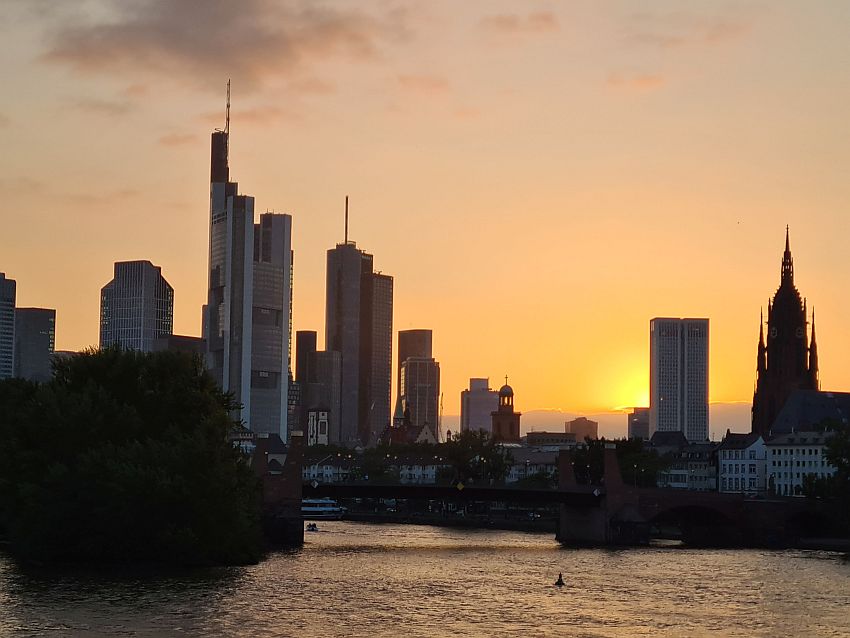
A brief history
First of all, I should point out that the city’s full name is Frankfurt am Main. The Main is the river that passes through the city. Founded by the Romans, Frankfurt became an important city in the Holy Roman Empire and functioned as an Imperial Free City (under the emperor) from 1372 until 1805, when the empire collapsed.
After just a few years as part of the Confederation of the Rhine (set up by Napoleon after he conquered the Holy Roman Empire), Frankfurt became a free city-state in the German Confederation, but that only lasted until 1866, when Prussia annexed it.
What’s most relevant to our story, though, is the fact that Frankfurt was bombed quite heavily during World War II, and the medieval city center was almost entirely reduced to rubble. It was after the war that the banking industry really took off in Frankfurt. At the same time, it rebuilt into a shiny modern city, complete with New York-style skyscrapers.
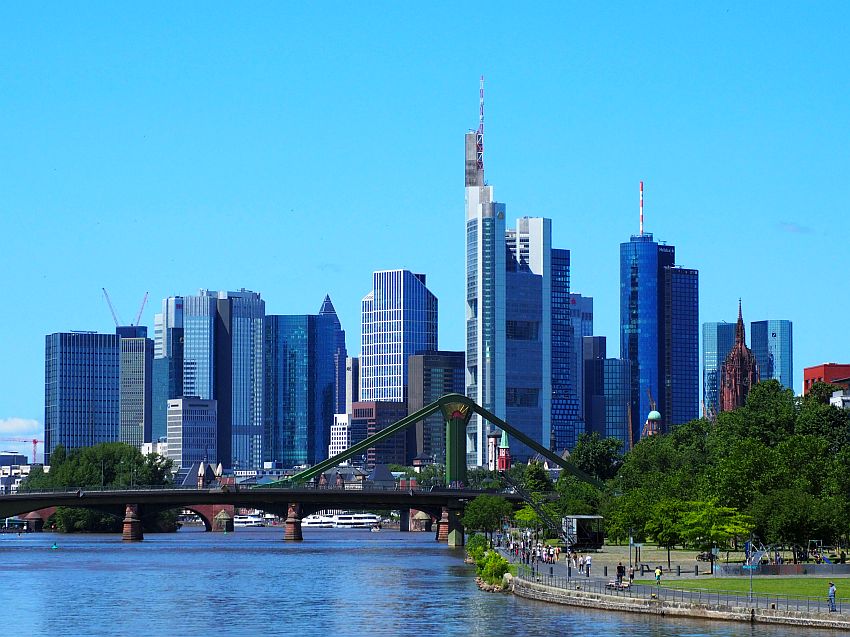
Frankfurt’s population today is about 750,000 people. It’s a very diverse population because of immigration (about 50 percent of residents have an immigrant background) but also because of the large expat population employed in banking.
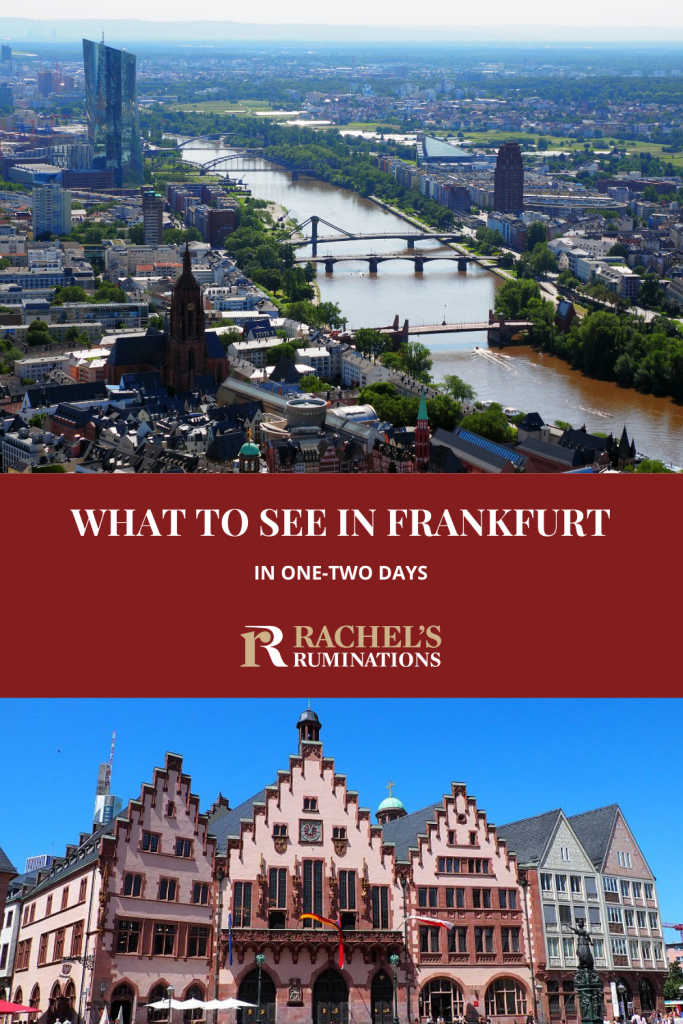
Must see in Frankfurt
I’m assuming you’ll spend two nights in Frankfurt, as we did, so you’ll essentially have one full day and possibly an afternoon on your arrival day and/or a morning on your departure day. In my view, there are three things you absolutely must see in Frankfurt:
- Römerberg and the New Old Town
- Kleinmarkthalle
- Main Tower
I’ll tell you about all three below. Besides these three sights, you should be able to visit one or two museums as well. They’re listed below too. Add in your travel time between sights and stopping for meals, and you’ll easily fill one whole day.
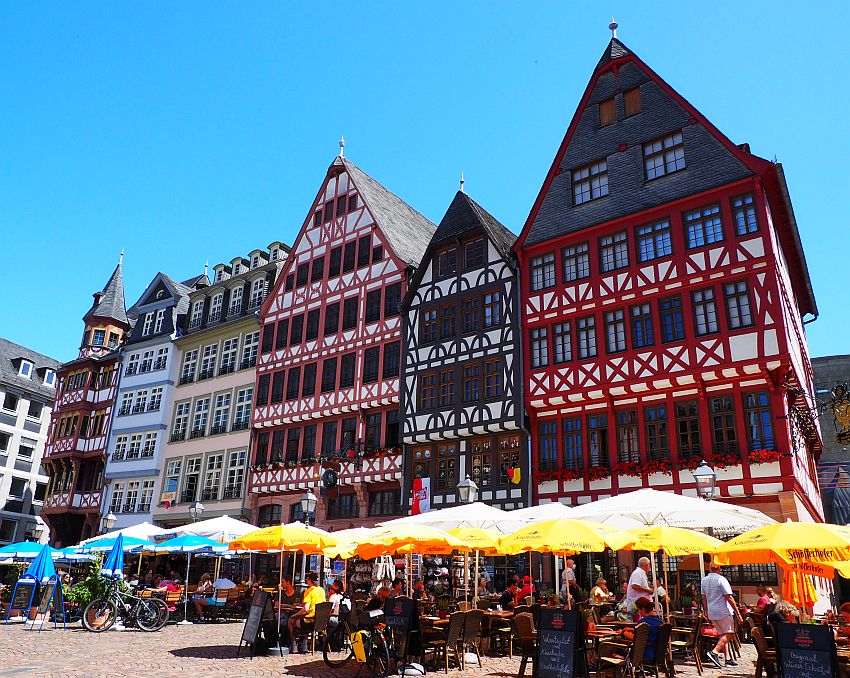
Depending on how much you want to do and see, it might be wise to pick up a Frankfurt Card. With this card you can travel on the trams and buses and get discounts at most of the museums and other sightseeing activities. You can order one here ahead of time. Alternatively, pick one up at a Tourist Information Office. There’s one in the airport, one in the main train station and another at Römerberg 27.
1. New Old Town
Frankfurt has rebuilt its “Altstadt” or old town. This wasn’t done soon after the war; the redevelopment of what is now called the New Old Town happened recently: in 2012-2018. For some of the buildings, pre-war floor plans or photographs helped the architects. For others, they designed matching facades to front modern buildings.
However it happened, they did a remarkable job, creating an authentic-seeming city core that was a delight for us to visit on a sunny summer day.
The most well-known part of the New Old Town is Römer, the old city hall. With its tall step gables and flanked by two similar replicas, it stands on a square called Römerberg. While those three buildings get the most attention, I found the whole square to be absolutely charming: see my photo above.
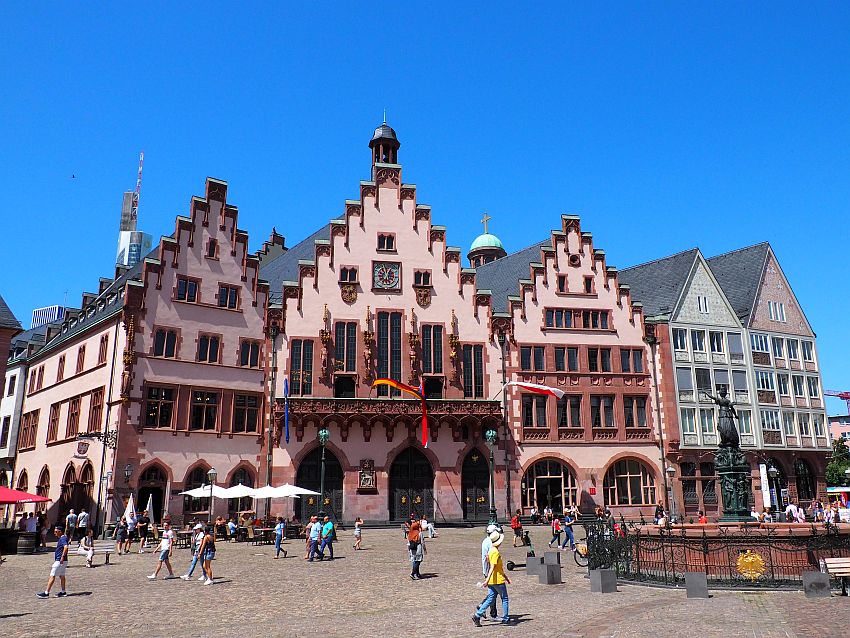
2. Kleinmarkthalle
Visiting markets is always fun. This one is wonderfully international, and worth a wander. You can pick up the makings of your lunch: in particular, look out for the tiny Schreiber’s Wurst on the side wall. It might have a line of customers waiting to buy these tremendously popular sausages. The restaurant at the back end of the market is very popular with locals, the crowds spilling out onto the plaza.
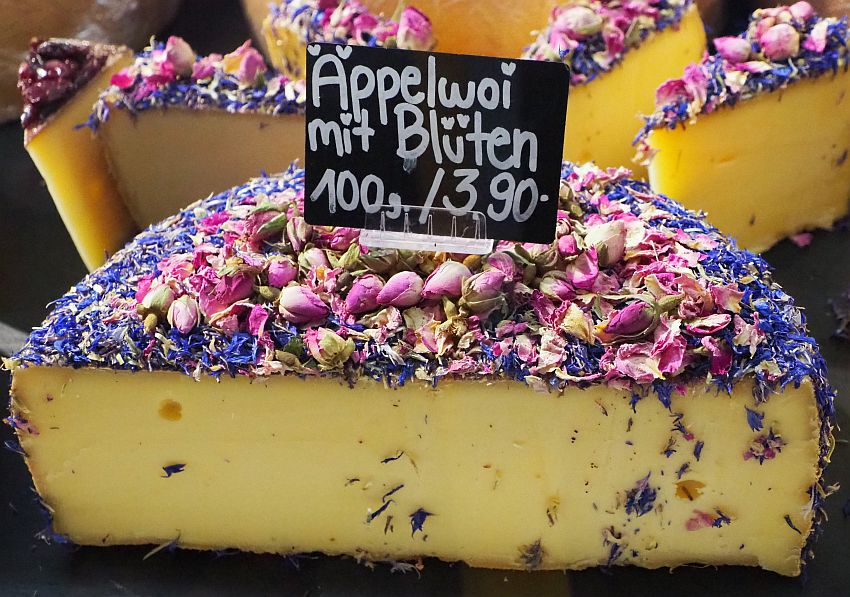
Kleinmarkthalle: Just outside the restored New Old Town in a nondescript 1950s building. Hasengasse 5-7. Open Monday-Friday 8:00-18:00 and Saturday 8:00-16:00. Website.
3. Main Tower
Main Tower is a tall office building in the business district among the skyscrapers. What makes it special is its observation deck, definitely worth a visit. The view is breathtaking on a clear day.
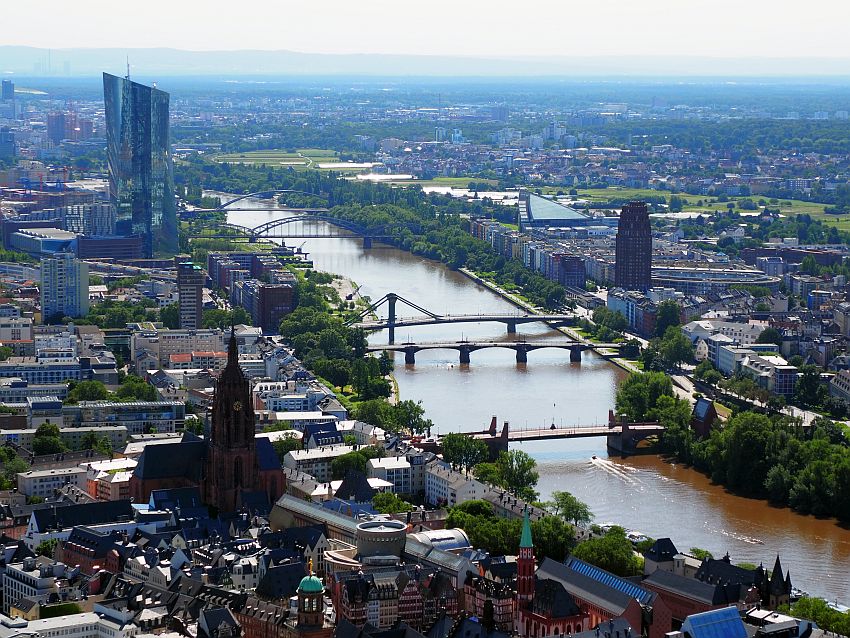
Main Tower: Neue Mainzer Straße 52 – 58. Open in summer Sunday-Thursday 10:00-21:00, Friday and Saturday 10:00-23:00. In winter: Sunday-Thursday 10:00-19:00, Friday and Saturday 10:00-21:00. Website.
Other things to see in Frankfurt
Frankfurt Cathedral
This was one of few buildings in the old city that partially survived the bombing. Though the church dates to the 14th century, its current incarnation is mostly a mid-19th-century creation, partially rebuilt after the war. You can go up the tower for the view of the New Old Town.
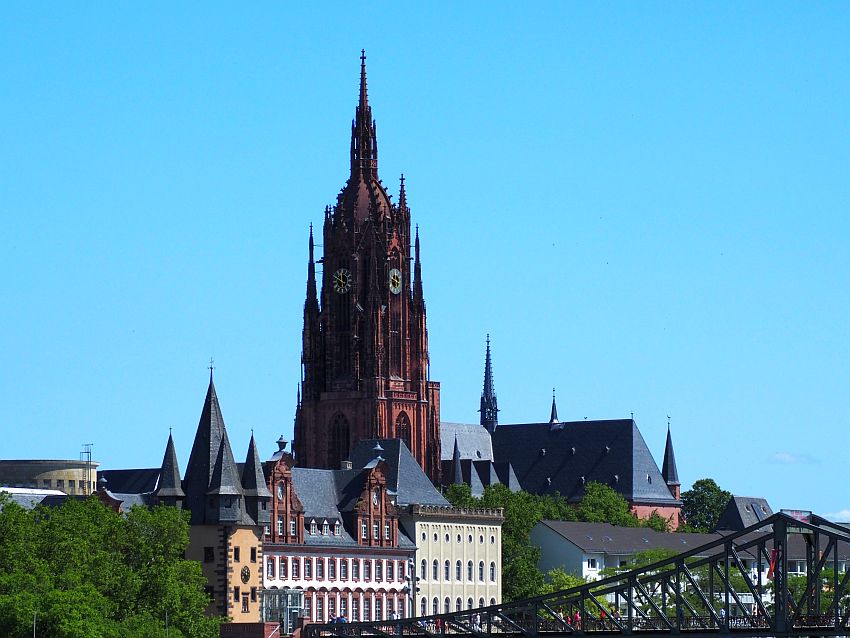
Frankfurt Cathedral: Domplatz 14. Open daily 8:00-20:00 except when services are underway. Website.
Goethe House
Goethe’s birthplace and childhood home, not far from the New Old Town, was built in 1749 and destroyed in the bombing. Rebuilt soon after the war according to the original plan, it’s been furnished to the period when Goethe lived there as a child in the 18th century. It’s a great way to gain some insight into how a well-off family of the time might have lived.
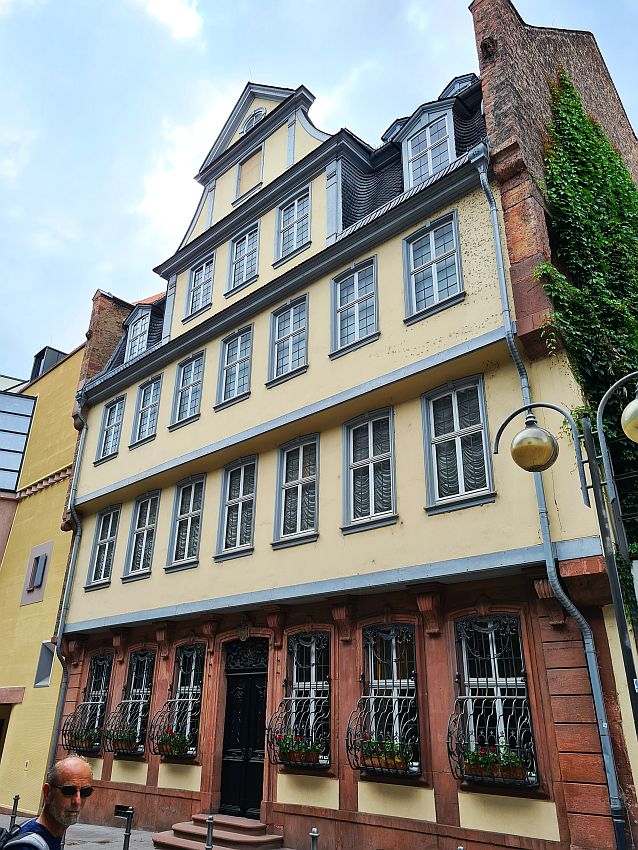
Frankfurter Goethe Haus: Großer Hirschgraben 23-25. Open Wednesday-Monday 11:00-17:00. Closed on Tuesdays. Website.
The Opera House
The Opera House is an ornate creation dating to the 1880s. It was a ruin for years and was rebuilt in 1981.
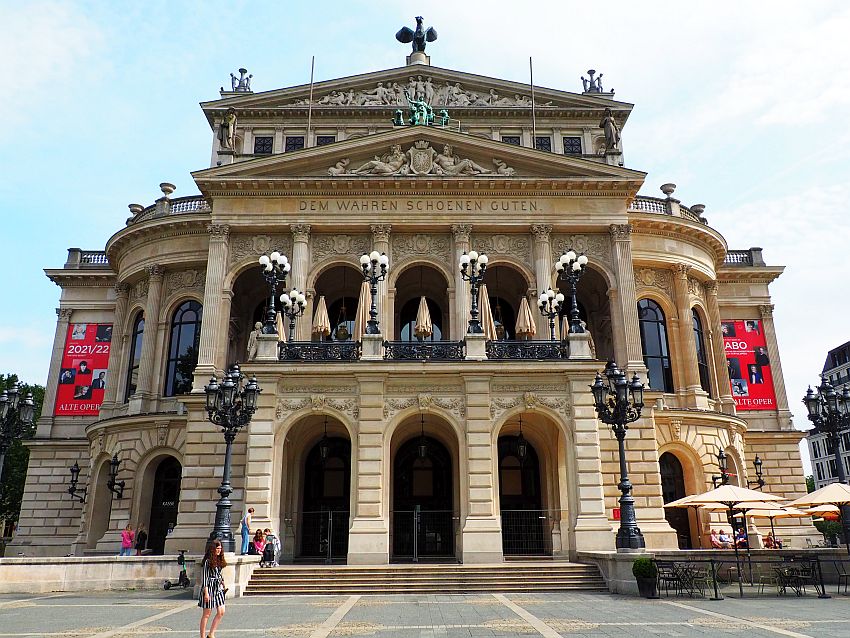
I loved the baroque façade and especially all of the funny faces I noticed on the exterior, presumably characters in operas. Nowadays the opera house is not used for operas but for other kinds of performance: theater, dance, concerts, etc.
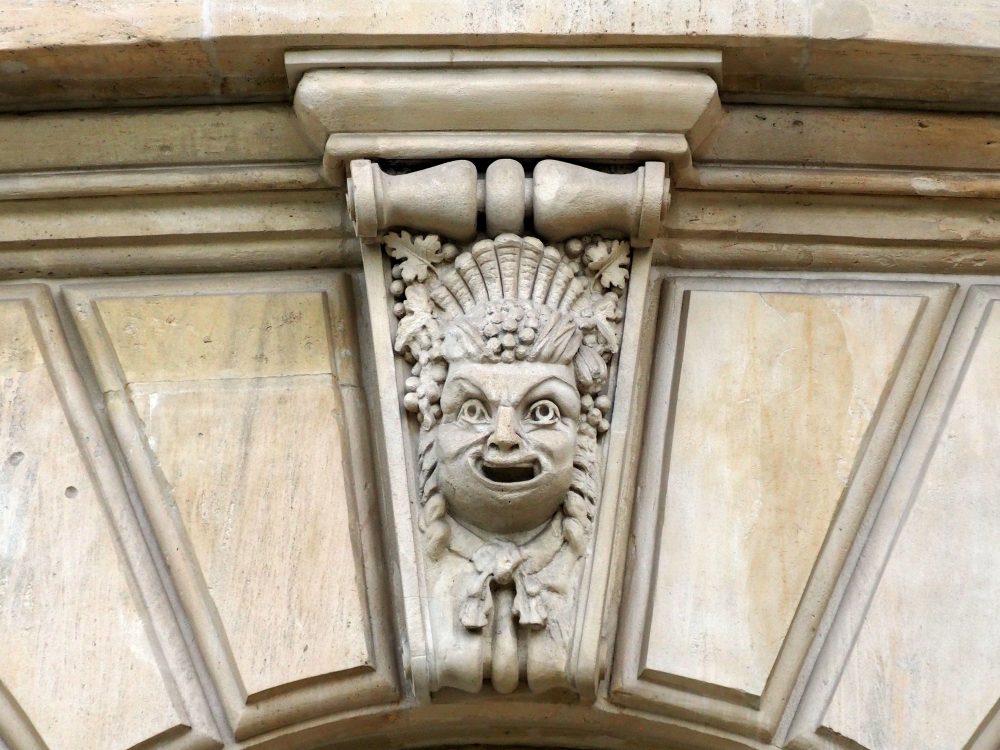
Oper Frankfurt: Opernplatz 1. Website.
Museums
Frankfurt has almost 40 museums ranging from the world class to the rather obscure. Some of them are on the Museum Embankment on Schaumainkai, the street along the south bank of the river opposite the Old New Town area. A famous iron pedestrian bridge crosses the river; you can get great views from it and admire the hundreds of “love locks” hanging from it.
Here’s a list of museums, divided generally by topic, including their address, hours and website.
Notice that almost all of them (Except Goethe House, the Money Museum, the Stoltze Museum, the Institute for City History and Senckenberg Museum of Natural History) are closed on Mondays, so take that into account as you plan!
You might also enjoy reading about thermal towns in Germany, some of which are quite near Frankfurt.
If city trips in Germany interest you, read A Maritime-Themed Weekend in Hamburg or A Weekend in Bremen, Germany.
Museums of the Arts
Caricatura Museum: Works of caricaturists. Weckmarkt 17. Open Tuesday-Sunday 11:00-18:00. Website.
Fotografie Forum: Photography. Braubachstrasse 30–32. Open Tuesday-Sunday 11:00-18:00. Website.
Frankfurter Kunstverein: Contemporary art and culture. Steinernes Haus am Römerberg
Markt 44. Open Tuesday-Sunday 11:00-19:00 and Thursdays until 21:00. Website.
German Architecture Museum: Architecture in an architecturally interesting building. Schaumainkai 43. Open Tuesday-Sunday 10:00-18:00. Website.
German Film Museum: History of film to today. My husband went to this one and reported that it has a very good exhibition on the history of film, starting from the very earliest forms. Schaumainkai 41. Open Tuesday-Sunday 10:00-18:00. Website.
Icon Museum Frankfurt: 130 Orthodox Christian icons. Brückenstraße 3-7. Open Tuesday-Sunday 10:00-17:00 and until 20:00 on Wednesdays.
Liebieghaus Sculpture Collection: Sculptures from ancient Egypt to neoclassicism, and a pretty garden. Schaumainkai 71. Open Tuesday-Wednesday 12:00-18:00, Thursday 10:00-21:00, Friday-Sunday 10:00-18:00. Website.
Museum MMK: Modern art in a post-modern building. Domstrasse 10. Closed at the time of publication. Check website.
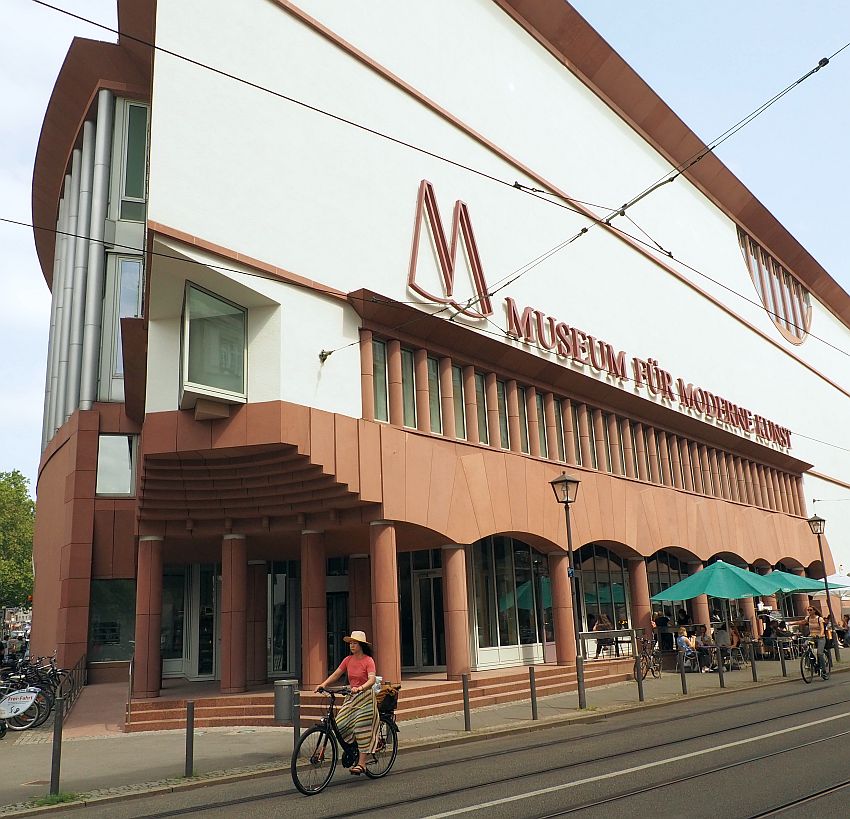
Tower MMK: A branch of Museum MMK, modern art from the 1960s to today. TaunusTurm, Taunustor 1. Open Tuesday-Sunday 11:00-18:00 and until 20:00 on Wednesdays. Website.
Museum of Applied Arts (Angewandtekunst): Design, fashion, handicrafts, graphics, etc. both historical and contemporary. Schaumainkai 17. Open Tuesday 12:00-18:00, Wednesday 12:00-20:00, Thursday-Sunday 10:00-18:00. Website.
Museum Giersch of Goethe University: Promotes the arts of the Rhine-Main region. Schaumainkai 83. Closed for renovations at the time of publication. Check website.
Portikus: Contemporary art. Alte Brücke 2. Open Tuesday-Sunday 11:00-18:00 and on Wednesdays until 20:00. Website.
Porcelain Museum in Kronberger House: Inside a 16th-century palace, ceramics, mostly rococo or neoclassical. Bolongarostraße 152. Open Saturday and Sunday 11:00-18:00. Website.
Schirn Kunsthalle: A huge floor space for rotating art and historical exhibitions. Römerberg. Open Tuesday-Sunday 10:00-19:00 and until 22:00 on Wednesdays and Thursdays. Website.
Städel Museum: European art from the 14th century to the present. Schaumainkai 63. Open Tuesday-Sunday 10:00-18:00 and Thursday 10:00-21:00. Website.
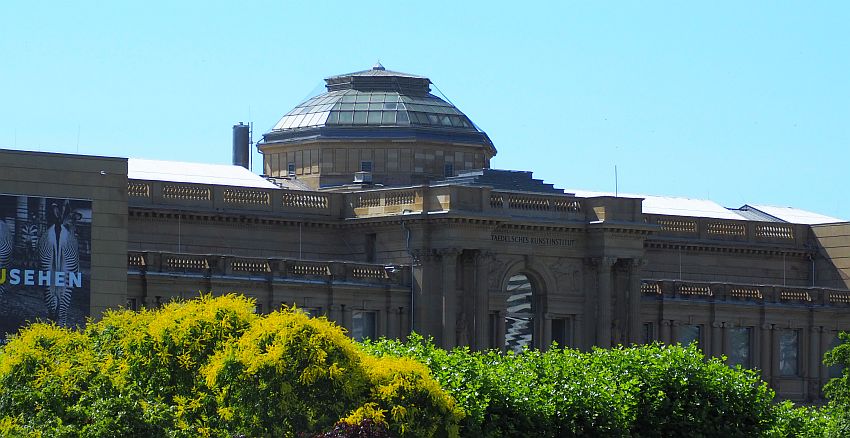
Money museums
Goldkammer (Gold Chamber): Everything about gold, from ancient history to today. Kettenhofweg 27. Open Tuesday-Sunday 11:00-19:00. Website (only in German).
Money Museum of the German Bundesbank: Everything about money, its history, and monetary policy. Wilhelm-Epstein-Straße 14. Open Sunday-Friday 9:00-17:00. Website.
European Central Bank Visitor Centre: All about what the ECB does to stabilize prices, etc. ECB Tower, Sonnemannstraße 20. Currently closed except for virtual visits. Check the website for changes.
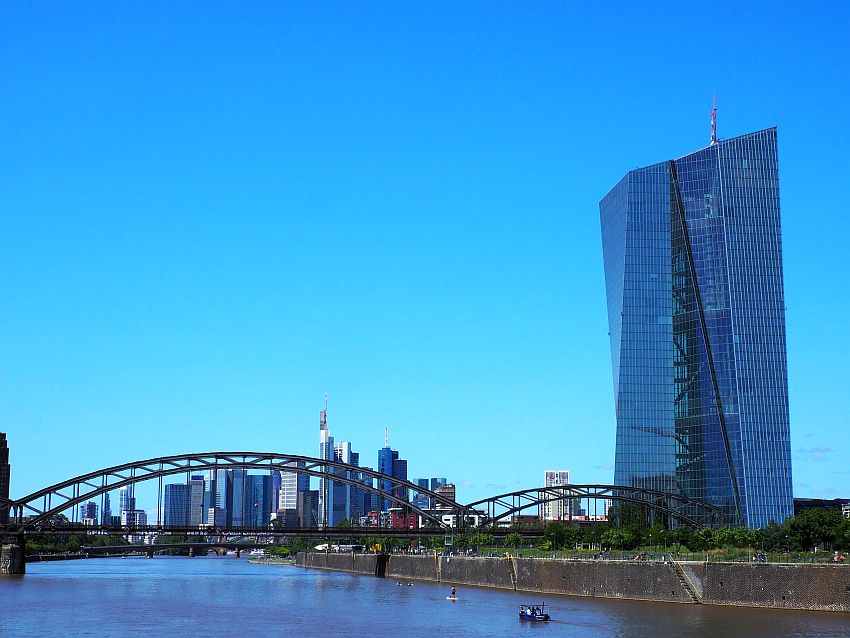
History and society museums
Anne Frank Education Centre: Multi-media exhibition about Anne Frank’s life as well as anti-semitism, racism and colonialism. Hansaallee 150. Open Monday-Friday 9:30-16:30. Website.
Archeological Museum: Covers pre-history to modern era archeology. Housed in a 13th-century former monastery. Karmelitergasse 1. Open Tuesday-Sunday 10:00-18:00 and Wednesdays until 20:00. Website.
Bible-House Experience Museum: About the Bible as a seminal text. Metzlerstraße 19. Open Tuesday-Saturday 10:00-17:00 and Sunday 14:00-17:00. Website.
Dommuseum: The Dom is the cathedral. This museum displays articles belonging to the Catholic church in Frankfurt. Domplatz 1. Open Wednesday-Friday 10:00-17:00 and Saturday-Sunday 11:00-17:00. Website.
Eintracht Frankfurt Museum: Frankfurt sports history, particularly the Eintracht soccer club. Main Stand at Deutsche Bank Park Stadium, Mörfelder Landstrasse 362. Open Tuesday-Sunday 10:00-18:00, closed on home match days. Website.
German Museum for Culinary Art and Table Culture: All about restaurants. Zeil 83 (entrance Holzgraben 4). Open Sundays 15:00-17:00. Website.
Historical Museum Frankfurt: Frankfurt, past and present. Saalhof 1. Open Tuesday-Friday 10:00-18:00 , Saturday-Sunday 11:00-19:00. Website.
Institute for City History: An archive of city history inside a former Carmelite Monastery, with medieval murals inside. Münzgasse 9. Open Monday-Friday 10:00-18:00, Saturday-Sunday 11:00-18:00. Website.
Jewish Museum Frankfurt: Jewish Frankfurt from the Middle Ages to the Holocaust. This is one of the two museums I went to. I’ll write about it in a separate article. Bertha-Pappenheim-Platz 1. Open Tuesday-Sunday 10:00-18:00 and until 21:00 on Tuesdays and Thursdays. Website.
Museum Judengasse: Part of the Jewish Museum. Focuses on Frankfurt’s Jewish ghetto through an archeological excavation of some of the houses. I visited this one too and will include it in my article about the Jewish Museum. Battonnstrasse 47. Open Thursday-Sunday 10:00-18:00. Website.
Museum for Communication: History of communication. Schaumainkai 53. Open Tuesday-Sunday 11:00-18:00. Website.
Museum of World Cultures: An ethnographic museum. Schaumainkai 29-37. Open Tuesday-Sunday 11:00-18:00 and Wednesday until 20:00. Website.
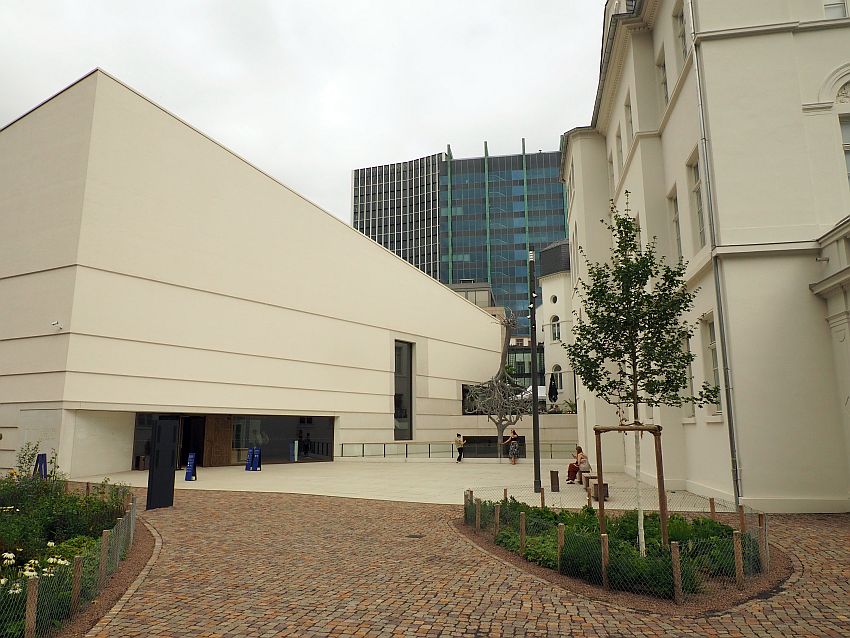
Museums about individuals
Besides the Goethe Museum I described above, there are a few more that focus on single individuals:
Hindemith Cabinet in the Cowherds’ Tower: Life and work of the composer Paul Hindemith inside a medieval fortification tower. Große Rittergasse 118. Open Sunday 11:00-18:00. Website.
Shock-Headed Peter Museum: Focuses on Struwwelpeter, a character from a children’s book, and the author of the book, Heinrich Hoffmann. Hinter dem Lämmchen 2-4. Open Thursday-Sunday 11:00-18:00. Website.
Stoltze-Museum der Frankfurter Sparkasse: The life and work of Friedrich Stoltze, writer and satirist. Markt 7. Open daily 10:00-18:00. Website.
For children
Experiminta ScienceCenter: A hands-on science museum. Great for kids. Hamburger Allee 22-24. Open Wednesday-Sunday 11:00-16:00 (These hours will expand so check the website.).
Senckenberg Museum of Natural History: Evolution, biodiversity and dinosaurs. Senckenberganlage 25. Open Monday-Friday 9:00-17:00, Saturday-Sunday 9:00-18:00, and until 20:00 on Wednesdays. Website.
Young Museum: Hands-on exhibitions, particularly crafts, for children. Saalhof 1. Open Tuesday-Friday 10:00-18:00, Saturday-Sunday 11:00-19:00. Website.
Other things to do in Frankfurt
Here are the other things we managed to fit into our visit:
Walking tour
It’s always a good idea in a new city to start off with a walking tour. It gives you the general background and helps you get oriented. Often you get insider tips as well. This was how I found out about the Kleinmarkthalle. The building is so unexceptional that I would have walked by it without noticing it.
Our tour was a private one courtesy of Frankfurt Tourism Board, but there are plenty of tour options: themed, walking, cycling, and lots of others. Click here for a list of possible tours.
A boat on the river
We spent a very pleasant hour on a boat ride on the river, which allowed us a great view of the tall buildings of the business district as well as a look at Frankfurt’s more industrial areas. An audio guide via loudspeaker points out the main sights, but doesn’t talk your head off. We had perfect weather and sat outside on the roof deck. It gave us a good sense of how Frankfurt residents use the riverbanks, which offer a lot of green space.
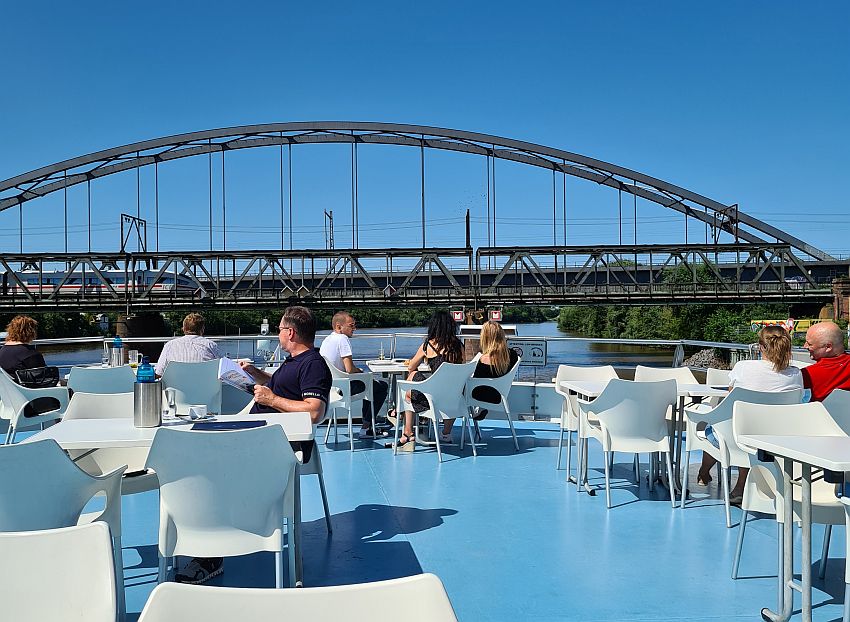
Two companies offer this service. We took Primus-Linie, which leaves from Eiserner Steg.
TimeRide (VR)
We made time for TimeRide as well. This is a virtual reality tour of Frankfurt in 1891. The experience starts with a rather cheesy introduction in a mock-up of an old-time grocery store. But after that, we sat in “carriages” wearing VR headsets, which took us on an entertaining animated carriage tour of Frankfurt.
TimeRide: Berliner Straße 42a. Open daily 10:00-20:00. More info and tickets.
Other possibilities
Hop-on Hop-off Bus
I’m not a fan of these, but I know many people swear by them, so I’m including them here. Frankfurt Sightseeing offers hop-on hop-off double-decker buses on a choice of two routes.
Palmengarten (Botanical garden)
A 22-hectare garden with 13,000 plant species from all over the world. I didn’t go, but it sounds lovely, especially the Palm House, a huge greenhouse dating to 1869.
Palmengarten: Enter from Palmengartenstraße or Siesmayerstraße. Open daily February-October 9:00-19:00 and November-January 9:00-16:00. Website.
Where to stay in Frankfurt
Lindley Lindenberg Hotel
We stayed at Lindley Lindenberg Hotel, in a business district slightly outside the center and just a few tram stops from the New Old Town.
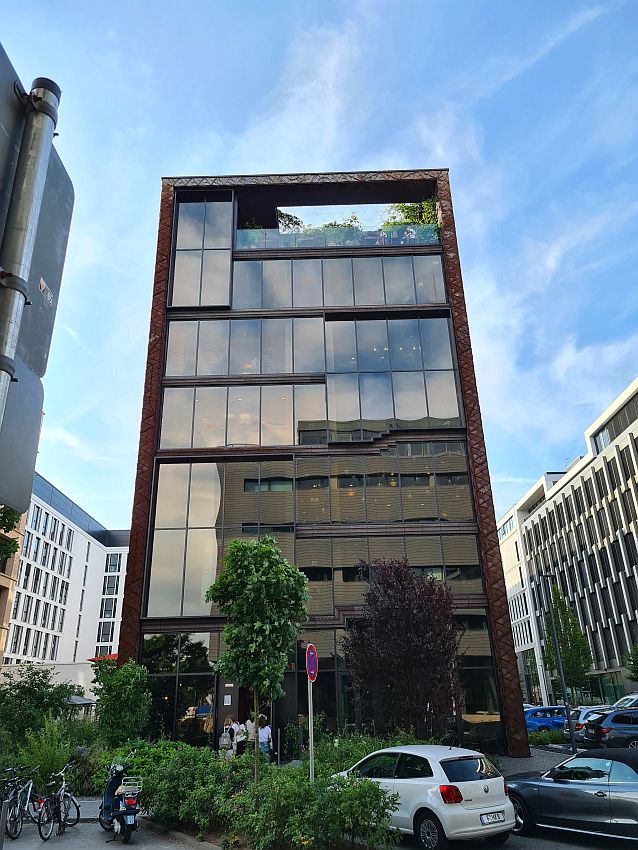
This is an unusual hotel. It looks on the outside like an office building, but it’s a chic boutique hotel, with stylish private rooms. The soundproofing was good except when the next-door building held a party right outside, but even then the sound wasn’t very loud. The bed and the room in general were attractive and comfortable.
The hotel has adapted some of the good things about hostels (common spaces) and left out the bad (sharing rooms and bathrooms with inconsiderate strangers). For example, two separate kitchens are available to guests, and guests can even help themselves to basics like rice and pasta. A Brita filter is built into the kitchen as well. In a herbarium, guests are welcome to pluck fresh herbs for whatever they’re cooking. Several common rooms feel homey like living rooms and are quieter than a typical lobby since no one is walking through them. The upstairs roof deck – not really on the roof but in the open air – is lovely, and so is the in-house pub.
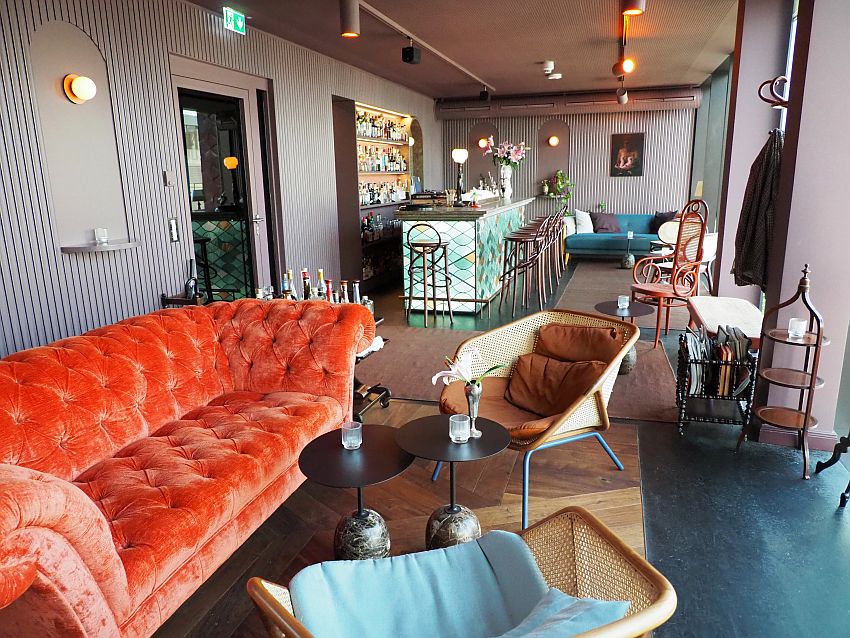
On the other hand, there were a couple of things that we didn’t like as much. You might have noticed that there’s a distinct trend in boutique hotels to have glass windows between their showers and their rooms. I don’t know about you, but I like my privacy when I shower! Well, Lindley Lindenberg takes it a step further: there’s no door or window on the shower. It opens onto the bedroom, with only an open shelf unit between it and the rest of the room.
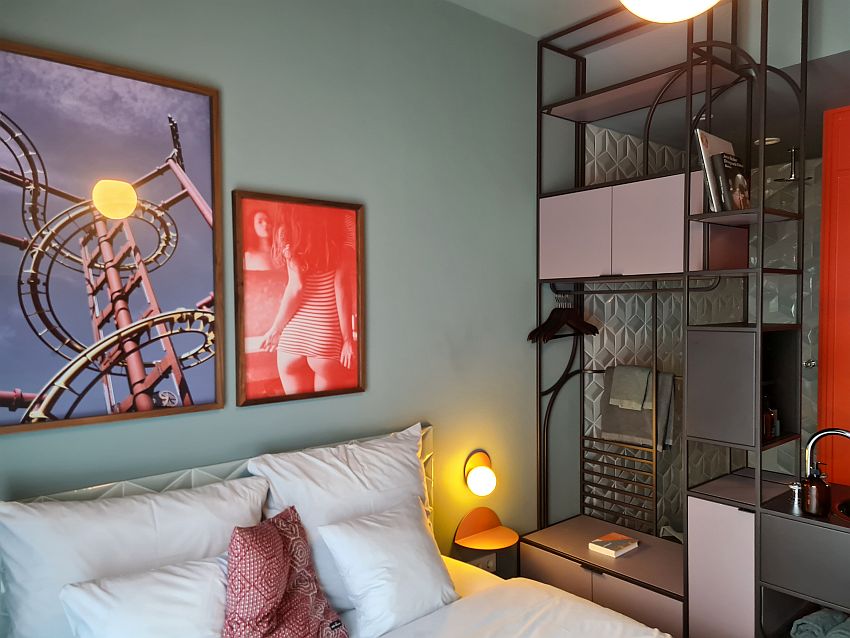
Secondly, the breakfast is vegan, which is great for vegans, but we non-vegans felt like something was missing. It included some delicious but quite small slices of bread and a few very small pots of food: hummus and oatmeal one day, pea mush and oatmeal the second day. Add a tiny bit of unidentifiable salad, a pot of jam, and a small glass of apple juice and that was it. This was not filling. And while there was coffee, there was no black tea on offer, so I missed my morning caffeine.
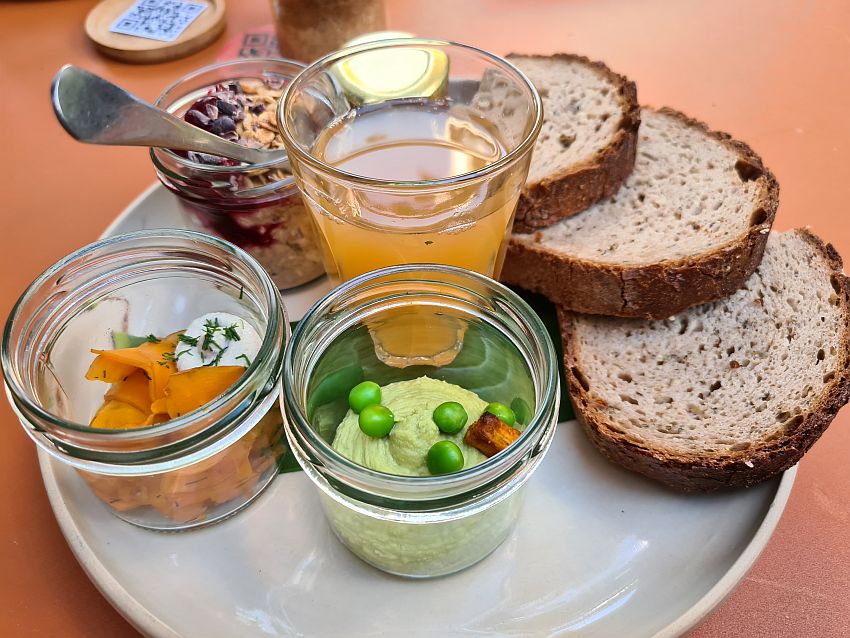
If the Lindley Lindenberg doesn’t appeal to you, there are plenty more options. The Stay22 map below shows VRBO accommodations (much like Airbnb) as well as Booking.com accommodations (hotels and other categories). You can check out all the accommodations by clicking on the map.
Eating in Frankfurt
I am no authority, but there are certain items that we were told we absolutely must try, since they are local specialties:
- Green sauce (grüne soße): This mild herb sauce is served over potatoes and hard-boiled eggs.
- Handkas mit musik: A sour milk cheese shaped into a round patty.
- Mispelchen: an alcohol drink mixing apple brandy and pickled loquats.
- Apfelwein (apple wine): A local version of hard apple cider, but not too sweet and not fizzy.
We tasted these at a restaurant called Lorsbacher Thal at Grosse Rittergasse 49 in the Sachsenhausen neighborhood but there are lots of places in that neighborhood that serve apfelwein and other specialties. Many of them, including Lorsbacher Thal, produce their own in-house version of it. I loved the apple wine, but it was sweeter than my husband likes.
Here’s another fairly random recommendation: our tour guide bought us some pastries from a cafe called Siesmayer and told us they were the best pastries in Frankfurt. I haven’t tasted all the others, but I can certainly say I believe her because they were amazingly good! Definitely go there if you’re in the area!
Cafe Siesmayer: Siesmayerstraße 59, right on the edge of the Palmgarten. Open Wednesday-Friday 8:00-17:00 (cake counter open until 18:00), Saturday-Sunday 9:00-18:00.
As I think you’ve seen, our very short visit to Frankfurt was only enough to get a small taste of the city, but it certainly made a good first impression. If you only have one or two days, I hope this article can help you choose what to see in Frankfurt. Let me know how it goes!
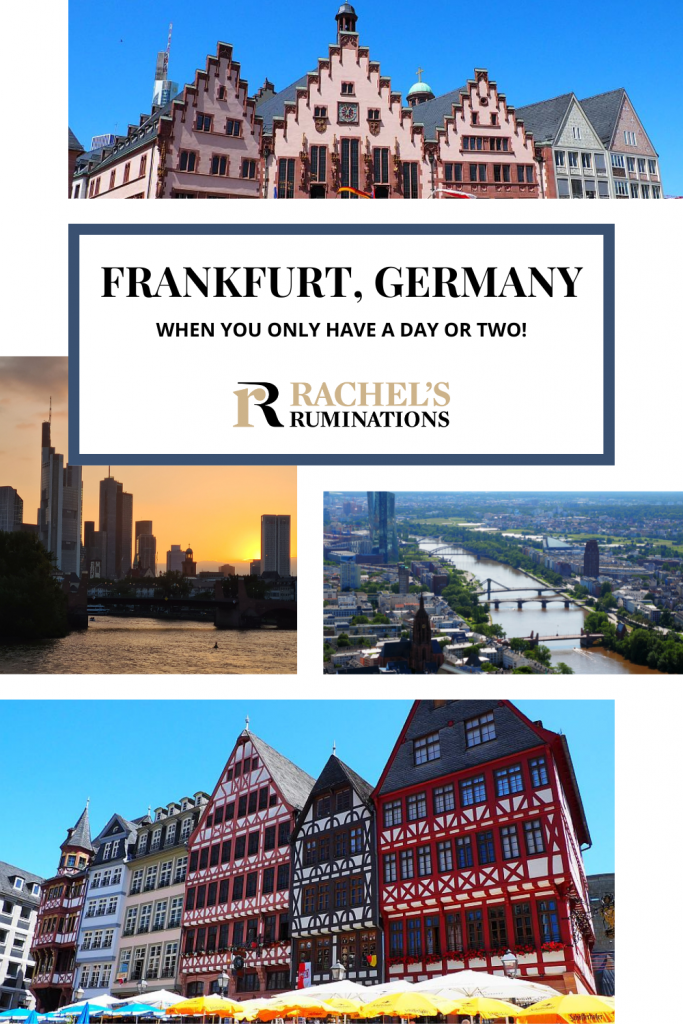


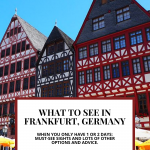
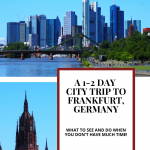
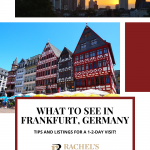
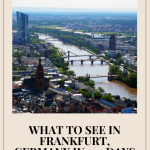
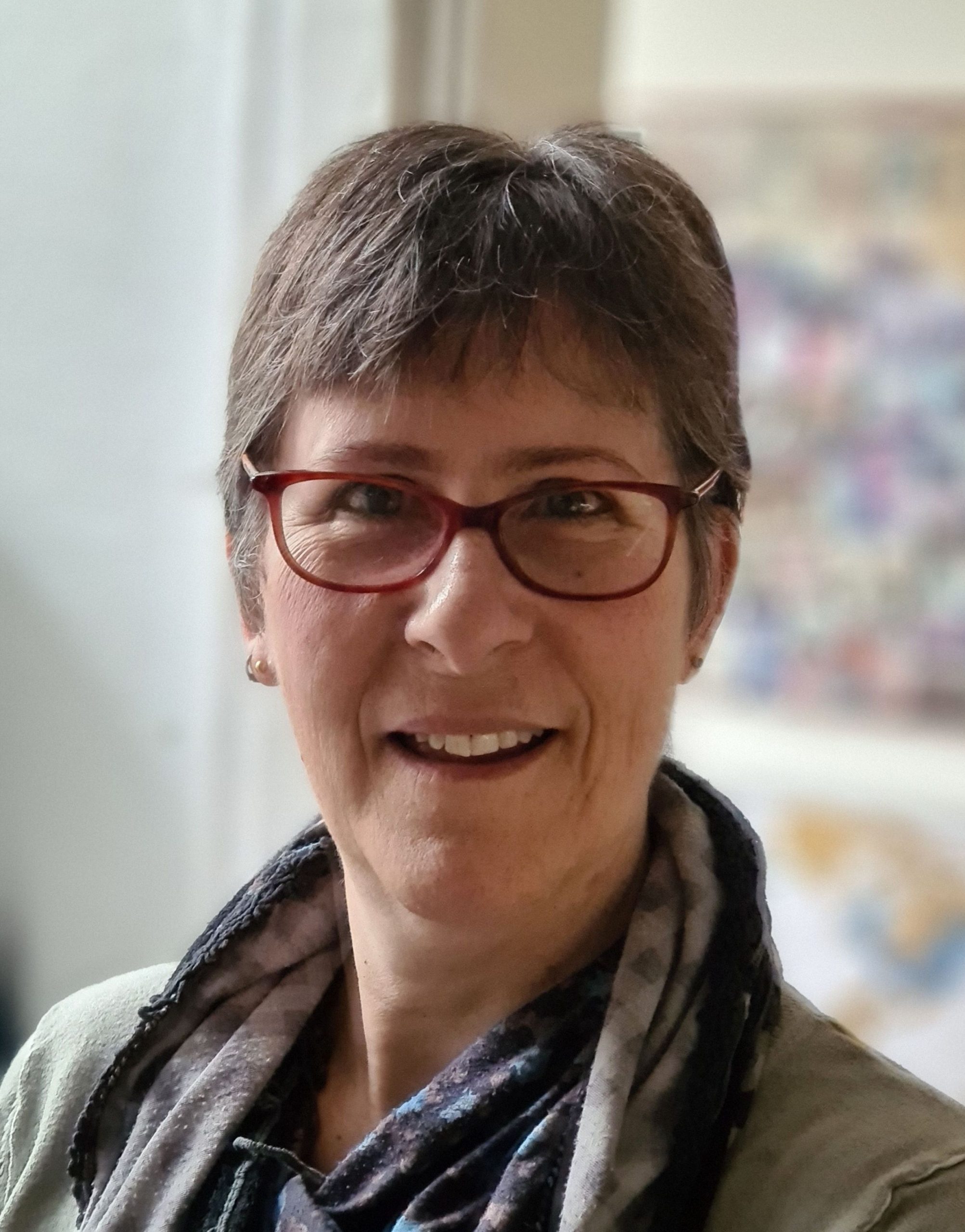
This is nice to read and I would love to be there one day.